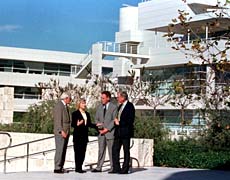
Museum
J. Paul Getty Museum (Los Angeles). The oil magnate's museum for European art expands its collection and moves to a new campus--"the most expensive art complex in American history" (Robert Hughes, Time). Modernist architect Richard Meier's eclectic buildings, which echo Le Corbusier and Frank Lloyd Wright, receive mostly raves. "A symphonic set of variations on the classical elements of 20th-century structure" (Herbert Muschamp, the New York Times). Some detractors say the buildings simply replicate Meier's designs for other galleries in Atlanta and Indiana. And some East Coast critics say Los Angeles doesn't deserve such a good museum. (Richard Meier plugs his project.)
Theater
The Old Neighborhood, by David Mamet (Booth Theater, New York City). The hard-edged playwright turns introspective with three autobiographical one-acts about his midlife crises and assimilated Judaism. "His most emotionally accessible drama to date," says the New York Times' Ben Brantley. As always, most critics rave over Mamet's sardonic humor and street-smart dialogue. Others complain the plays are pretentious and without much plot. Some detractors ridicule Mamet's language for its "terrible syntax, clichés, non-sequiturs, idiocies--but, man, that's how people talk!" (John Simon, New York).

Movies
Flubber (Buena Vista Pictures). Disney's remake of TheAbsent Minded Professor (1961), with Robin Williams in the lead role, draws a big audience (earning $10.7 million its opening weekend) and critical derision. "Slow, flat and dumb" says the Chicago Sun-Times' Roger Ebert. Critics find Williams' character surprisingly unlikable, causing some to conclude that the comedian has hit a midcareer slump. The film's saving grace is its special effects, particularly the green, gravity-defying slime that Williams' scientist creates. (See Disney's site for the movie.)
Welcome to Sarajevo (Miramax). Respectful doubts about this film about a British war reporter who saves an orphaned Bosnian girl. Reviewers say its conventional use of melodrama cheapens the atrocities of the Yugoslavian war. "Some of the shocks here are too sadly predictable," says the New York Times' Janet Maslin. Still, critics applaud its explicit condemnation of the United States' passive Bosnia policy, and Woody Harrelson's portrayal of a blowhard TV reporter.
Television
Public Housing (PBS; click here for local listings). Veteran filmmaker Frederick Wiseman's three-hour documentary about a Chicago public-housing project wins critical approval. Reviewers praise Wiseman's signature minimalist style--no narrator, no music, long unedited scenes--and his willingness to face up to the intractability of poverty. "Like a dense poem," says the Chicago Tribune's Steve Johnson. Wiseman reveals "the impotence, for poverty, of the talking cure--the endless stream of sex-education classes, group-therapy sessions, self-esteem talks ... directed by the haves at the have-nots," says Slate's Walter Kirn. (PBS plugs the show.)

Book
Release 2.0: A Design for Living in the Digital Age, by Esther Dyson (Broadway Books). Critics scoff at high-tech guru Esther Dyson's claims that the Internet will expand democracy, build communities, and liberate workers. "A cross between New Age philosophy and 1950s hyperbole," says Slate's Joseph Nocera. The New York Times' Michiko Kakutani says Dyson naively "downplays the [Web's] perils," among them new opportunities for invasive voyeurs and shysters. Others gripe that Dyson recycles her previously published magazine articles, writes turgid prose, and puts too much faith in the free market. (Click here for the Release 2.0 site.)
Photography
"Weegee's World: Life, Death, and the Human Drama" (International Center of Photography Midtown, New York City). With this retrospective, the newspaper photographer Arthur Fellig a k a "Weegee" (1899-1968) is judged a technical virtuoso, a great artist, and an inspiration to his followers. Critics marvel at his knack for arriving at murder scenes before the police. Others blame him for today's news media's voyeurism and disapprove of his borderline ethics (he composed scenes that he passed off as spontaneous). "His influence was like a rock dropped in a pond: its ripples are still spreading," says the New York Times' Vicki Goldberg. (Click here for the museum's site and here for Weegee samples.)
Update
The New Republic's Stanley Kauffmann calls Francis Ford Coppola's The Rainmaker generic. "Must we simply face the iron fact that current filmmaking conditions have deprived still another individual director of his individuality?"
Recent "Summary Judgment" columns
Movie--Midnight in the Garden of Good and Evil;
Movie--John Grisham's The Rainmaker;
Movie--Alien Resurrection;
Book--Ronald Reagan: How an Ordinary Man Became an Extraordinary Leader, by Dinesh D'Souza;
Theater--Ivanov;
Music--Standing Stone, by Paul McCartney.
Movie--The Jackal;
Movie--Anastasia;
Movie--The Sweet Hereafter;
Theater--The Lion King;
Book--Another City, Not My Own: A Novel in the Form of a Memoir, by Dominick Dunne;
Art--"Egon Schiele: The Leopold Collection, Vienna" (Museum of Modern Art).
Movie--Starship Troopers;
Movie--The Wings of the Dove;
Movie--Mad City;
Theater--Proposal;
Book--The Dark Side of Camelot, by Seymour M. Hersh;
Book--Alfred C. Kinsey: A Public/Private Life, by James H. Jones;
Book--Joy of Cooking: The All-Purpose Cookbook;
Art--"The Warhol Look/Glamour Fashion Style" (Whitney Museum).
Music--Spiceworld, by the Spice Girls;
Museum--P.S. 1 Contemporary Arts Center;
Movie--Red Corner;
Book--Violin, by Anne Rice;
Book--My Brother, by Jamaica Kincaid;
Opera--Xerxes, New York City Opera.
--Franklin Foer
